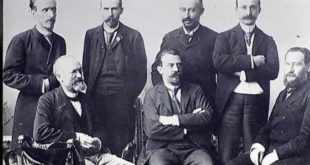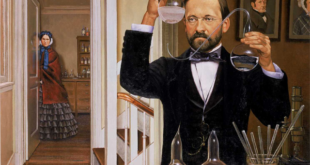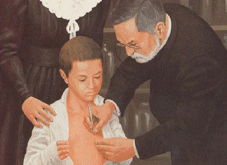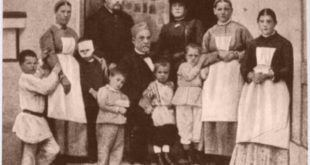Originally published in The American Magazine, Volume 22, July to December 1886, pp.341-349
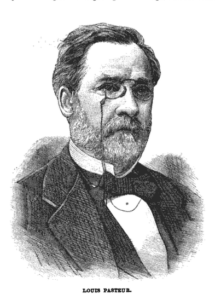
Pasteur’s first work was in the field of molecular physics, and the important discovery of molecular dissymmetry was originally due to the note which Mitscherlich sent to the Academy of Sciences. This note stated that the,
“Paratartrate and the tartrate of soda and ammonia have the same chemical composition, the same crystalline form, the same angels, the same specific weight, the same double refraction, and consequently the same inclination of the optic axis. Dissolved in water, their refractions are the same. But, while the dissolved tartrate causes the plane of polarized light to rotate, the paratartrate exerts no such influence.”
This difference of behavior of polarized light made Pasteur infer that the identity of the two salts was only apparent, not real, and that further research would reveal molecular discrepancies of an important kind. He verified his belief; but somewhat in a different way from that which he had expected. He expected to find, and he found, that the crystalline forms of the tartrates, and all their chemical compounds, have not what mathematicians call a “plane of symmetry”–that is, are not among those objects which, when placed before a mirror, have a superposable image identical with themselves, and are therefore dissymmetrical; while, on the other hand, he believed that the paratartrates would have this plane of symmetry, this superposable image, and be therefore symmetrical. He found, instead, that all the paratartrates were dissymmetrical like the tartrates; but certain crystals possessed this dissymmetry in one sense and other crystals in an opposite sense.
“Some of these crystals, when placed before a mirror, produces the image of the others, and one of the two kinds of crystals corresponded rigorously in form with the tartrate prepared by means of the tartaric acid of the grape.”
Then by saturating racemic or paratartaric acid with soda and ammonia he procured crystals of inverse dissymmetry–the one set turning the plane of polarized light to the right (dextro-racemic acid), the other to the left (lævo-racemic acid). Of these the left-handed crystal was the new discovery, though Biot had already proved the existence of this double property in rock-crystal. This inversion is due to certain minute facets which, in the one crystal, are ranged along a right-handed, and in the other along a left-handed, spiral.
More, again, than this, Pasteur proved that all the crystalline products of inorganic matter have this superposable image, and are consequently symmetrical; while all vegetable and animal products, all crystals produced from organic and living beings, are dissymmetrical. The explanation he gives of the apparent contradiction to this law, in the existence in living creatures of certain substances like oxalic acid, formic acid, etc., which do not act on polarized light, and of which the crystals do not show a trace of dissymmetry, is an example of his acute power of classification. It is, he says, because these substances are the products of excretion rather than substances essential to animal and vegetable life, hence are,
“Evidently governed by the laws which determine the constitution of the artificial products of our laboratories or the mineral kingdom, so called.”
On the other hand, the primordial substances of vegetables and animals, those which are
“born under the influence of becoming life, such as cellulose, fecula, albumen, fibrine, etc., possess the power of acting on polarized light, which established their internal dissymmetry, even when, through the absence of crystallizing power, they fail to manifest this dissymmetry outwardly.”
Hence he is persuaded that the barrier which exists between the mineral and organic kingdoms can never be crossed until chemists have been able to produce dissymmetrical inorganic substances. This may some day be done; who knows? As the inverse of right-handed tartaric acid has been found, so some day, we may hope to obtain “all the immediate principles inverse to those now known to us.” If that day should ever dawn, then man be indeed the lord of creation in a higher sense than that of relative superiority. He will be the maker of new types, new beings, new organisms altogether; and to replace in the living cells “cellulose, albumen, and their congeners by their isomers, with an inverse action,” would be to change the present molecular order of arrangement of things as completely as if plants should be made to walk and animals to root.
Now we leave molecular physics and go into organisms, to which these have been, as it were, the alphabet or stepping-stones.
The putrefaction of a dead body and of blood, the must of the wine cask, the curdling of milk, the souring of dough, the transformation of straw into manure and of fallen leaves into soil, are all due to one thing–fermentation. And fermentation is due to a living organism differing is size and form according to the vehicle in which it lives. Cagniard-Latour and Schwann had before this discovered the yeast-plant, the alcoholic ferment; but it remained for Pasteur to find the infusoria of other fermentations.
Lactic ferment, which was the first subject of investigation on which Pasteur “intended his mind,” according to Bacon’s expression, is a minute rod, nipped at the centre, scarcely the thousandth part of a millimètre in diameter, a millimètre being one twenty-fifth of an inch. This rod reproduces itself by fission, dividing at the nipped-in centre. Up to this time the cause of fermentation had been in the theoretic stage only, where all proof was wanting, and where, therefore, the believers in such and such a baseless hypothesis were hot partisans, firmly convinced of their own truth and passionately scornful to their opponent’s error. Liebig held all ferments to be nitrogenous substances in a state of molecular alteration through contact with the oxygen of the air; and fermentation to be the gradual communication of this molecular motion from particle to particle in the fermentable matter. Berzelius and Mitscherlich placed fermentation among the “phenomena of contact.” It was an albuminoid substance endowed with catalytic force (the power of decomposing and recombining the proximate and elementary principles of compounds), and acted by its mere presence. Cagniard-Latour and Dumas saw that yeast multiplied itself by budding, and came near the truth when they asked whether the “fermentation of sugar was not connected with this act of cellular vegetation.” But this hypothesis “remained a single incident instead of having the value of a scientific principle,” until Pasteur recognized the presence and action of a living organism in lactic fermentation; and from this starting-point proved all the rest. He discovered the hitherto unknown ferment of butyric acid, which he found to be a species of vibrio, formed of very small transparent and cylindrical rods, “rounded at their extremities, isolated or united in chains of two or three, or sometimes even more.” These vibrios reproduce themselves by fission, like the lactic ferment, but differently, inasmuch as these remain in chains where the lactic ferment forms isolated units. They live without air, and are therefore called anaérobies; while those other microscopic organisms which, like larger plants and animals, cannot live without free oxygen, are aérobies. Whether this vibrio be a plant or an animal, it is undoubtedly a living organism which moves, is a ferment, and lives without air. Putrefaction is caused by a microscopic vibrio absolutely the same order as this butyric ferment.
We have no space to give in extenso Liebig’s words when he objected that, to explain the putrefaction of animal substances by the presence of animalculæ, was like the reasoning of a child who should explain the rapidity of the Rhine at Bingen by the wind-wheels of Mayence. If living beings cause putrefaction, what, then, becomes of those plants or animals when their own elements decompose? If the fungus causes the oak to decay, and the microscopic animalcule is the putrefying agent of the elephant, what determines the putrefaction of the fungus and animalcule when they in their turn die? To which Pasteur answered: “The ferments of ferments are simply ferments.” ” A ferment which has finished its work, and which, for want of aliment, cannot continue it, becomes an accumulation of dead organic matter.” This mass of organic matter, formed by the anaérobies, becomes the prey of the aérobies, which multiply and continue their work of destruction so long as they have free oxygen. Those which die are equally the prey of their own kind; so
“that from putrefaction to putrefaction, and from combustion to combustion, the organic mass with which we started finds itself reduced to a mass of anaerobic and aerobic germs, of those same germs which were mixed up in the original primitive organic substance.”
This is the whole round of life–birth, assimilation, death, putrefaction, slow combustion, and the transformation of “carbon, the hydrogen, and the nitrogen of the organic matters by the oxygen of the air and the influence of the life of these aérobies into carbonic acid, vapor of water and ammonia gas,” by which, again, organic beings are nourished. Whether in the free atmosphere or under the earth, all animal matter ends by disappearing; the anaérobies first putrefying, the aérobies then oxygenizing, and so producing the combustion which burns away matter into gas.
“All that has lived must die, and all that is dead must be disintegrated, dissolved or gasified; the elements which are the substratum of life must enter new cycles of life. If things were otherwise, the matter of organized beings would encumber the surface of the earth, and the law of the perpetuity of life would be compromised by the gradual exhaustion of its materials. One grand phenomenon presides over this vast work–the phenomenon of fermentation.”
And the scientific world has endorsed, not only the statement of the elemental fact, which is patent, but also that of the cause, the primum moveus of the modus operandi.
Wine, exposed to the air, loses its alcohol, which is replaced by acetic acid, and thus becomes vinegar. And vinegar is the work of an extremely small and slender fungus, Mycoderma aceti, like the aérobies, needing free oxygen as well as a certain amount of warmth for its support. Temperature, indeed, plays a most important part in the life of these organisms, extreme cold or extreme heat being equally fatal to them. After all the alcohol has become acetic acid, the mycoderma dies for want of further nourishment, and falls to the bottom of the vessel. Here it is fastened on by the anaérobies, which, protected from the air by the film of “aérobic mucor” on the top, set up putrefaction in the deeper parts of the liquid. At the same time the surface is undergoing combustion by the fixing of the oxygen by the aérobies, which double action irretrievably ruins the whole concern. Besides this cryptogram which turns wine into vinegar, transparent eel-like organisms of ext4raordinary rapid reproduction appear in the liquid when exposed to the air. These eels and the plant are enemies, and fight for the free oxygen. In healthy vinegar the plant conquers, and the eels retreat to the sides of the vat, where they form a thick, white, crawling scum. Thus, instead of the old theory of chemical combinations mechanically affecting inert matter, we have now the proof of the active agency of living organisms–by which the whole outlook of things is changed–reproductive Life being substituted for sterile Force and Matter re-Motion.
The commercial value of these researches on the true cause of acetification is the power of the manufacturer to create vinegar at will, by sowing the mycoderma directly in the wine vats instead of waiting for more costly, tedious, and not always sure method of the mother-cask.
Besides the fact that the ferment is always a living organism, Pasteur also demonstrated that of a variety of species. Each kind of fermentation has its own special organism. Also, he showed that the albuminoid matter, held by Liebig and others to be necessary to fermentation, was in reality superfluous. This he showed in the experiment already spoken of on the growth of Penicillium glucum–that common mold or mildew which lived and multiplied on a purely mineral soil.
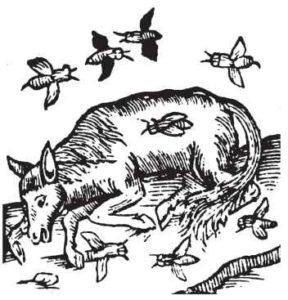
After this a curious controversy on spontaneous generation between Pasteur and Pouchet foreshadowed that which went on here between Professor Tyndall and Dr. Bastian. Pasteur and Tyndall maintained the germ theory, and held that the appearance of monads, bacilli, etc., in prepared flasks, is due to some flaw in the experiment by which the germ-laden atmospheric air has been admitted; while Pouchet and Bastian nailed their colors to the mast of abiogenesis and the beginning of life under certain conditions without the cansation of the parent germ. Their ideas on spontaneous generation, however, fell short of Van Helmont’s when he declared that he could create a pot-full of mice by stuffing a dirty shirt into the orifice of a vessel containing corn; nor did they touch Virgil’s belif of a swarm of bees generated int eh corrupted entrails of a young bull. Pasteur, like Tyndall, showed that the total exclusion of atmospheric air sterilized the infusion, while the admission of ever so little by defective arrangements produced swarms of microscopic organisms. Also he showed that in the higher atmosphere no germs exist at all–few or none, according to relative altitude, on mountain heights–comparative rarity in unpopulated plains, etc., and great density in towns. He ended his disclaimer by these words: “Spontaneous generation is a chimera.” Nevertheless, it would seem that we may still hope to catch the transitional moment, and to light on the same conditions as those wherein the primordial germ became life. IF right-handed tartrate of ammonia proves more capable of supporting life owing to its molecular arrangement, molecular arrangement may be found to be that borderland between the organic and the inorganic which unites inert matter to conscious action. What has been can be again, unless, indeed, this telluric and cosmic germ was the product of conditions passed and done with, adn impossible to be reproduced.
The cryptogram, Mycoderma aceti, makes wine into vinegar; its congener, Mycoderma vini, which lives on new, young wine, fades and withers in old and does no harm. When, however, wine “spurts” in the barrel, is turbid to the eye and flat to the taste, when, poured into a glass, a crown of small bubbles rises to the top, and when, slightly shaken, silky little waves move about in the all directions, then a minute filament, about he thousandth part of a millimeter in diameter, of variable length and extremest tenacity, has made its appearance. In large quantities this organism forms a glutinous deposit at the bottom of the ask, producing carbonic acid, which spoils the wine. The disease of turbid, spurted, and spoiled wine is fermentation, caused by an organism–a ferment–originally existing on the surface of the grape, where also exists the organism which causes the orderly and vinous fermentation. All red wines, especially the finest of the Còt d’Or are subject to this disease, which makes them bitter and unfit to drink. White wines, on the contrary, are exempt from this, but are subject to another disease called maladie de la graisse, they, too, become turbid; but where the red are bitter, these are flat, insipid, and viscous. This maladie de la graisse is due to a filamentous organism like that which makes red wine spurt; but the two differ in structure and physiological action. The remedy in either case is to kill the organism by heat. One minute’s heating at the proper temperature is enough to preserve the wine from all the diseases caused by fermentation. This heating in no wise affects the most delicate bouquet of the most delicate vintages; and, though experts at first professed to detect a shade of difference in the flavor between the heated and the unheated wines, when they had detected a like shade between two glasses poured out of the same bottle they confessed their defeat; and Pasteur’s remedy by calorification was justified.
We all know the importance of the silkworm industry to France. In 1849, after an exceptionally good year, a disease like an epidemic fell on the silkworm nurseries. This disease had different times of manifestation. Either the eggs were altogether sterile, or the worms died soon after they were hatched, or else their first, intermediate, or last moltings were failures, after a perfectly satisfactory hatching. They were attacked indiscriminately in every phase of their existence. The silkworms did not eat; and eating is the whole life of the silkworm till it becomes a chrysalis. So far from that vigorous and voracious “munching which sounds like rain falling on thick bushes,” the worms turned away from their leaves as sick children refuse their food. The invalids were smaller than the others, had a shining appearance and a blackish tint; and if they did not die before the first molting and went on even to the fourth, they did not then turn white as they should, but retain a rusty tint.
“Spots appeared on their bodies, black bruises irregularly scattered over the head, the wings, the false feed and the spurs.”
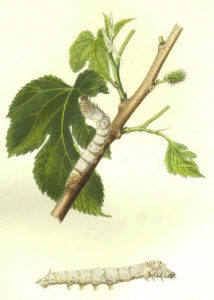
They died by the hundreds; and the silkworm industry was seriously threatened and harmed. 1850 and 1851 were bad years; and then fresh eggs were brought from abroad, which gave to 1853 an exceptionally fine crop. In 1854, when the new eggs had become moths and the moths had laid their eggs in the infected nurseries, things were as bad as ever. Spain and Italy also suffered, and all the new eggs brought from the as yet healthy districts in Europe become infected int he same way. The disease follow the trade in eggs. In 1864 the whole of the silkworm establishments in Europe were attacked, and in the extreme East only Japan was free from disease. No remedies were of the least use. Flowers of sulphur, cinder, soot, spread over the worms and mulberry-leaves; gaseous fumigations of chlorine, tar, sulphuric acid; not even treating the worms with wine, rum, absinthe–the absinthe to be followed by creosote and nitrate of silver–none of all those prophylactics had more effect than the cabalistic words, written on a piece of paper and washed off into a glass of water, used to have against fever or ague. The epidemic continued; the worms died; and the silkworm industry was at the lowest possible ebb. Then M. Pasteur was persuaded to leave his ferments and apply himself to a scientific investigation of the silkworm disease.
On the 6th of June, 1865, he started for Alais; and by the evening of the same day he had detected microscopic corpuscles in the bodies of the infected eggs, worms and moths. Other men of science had also detected these corpuscles. In a memoir to the Academy of Sciences, M. de Quatrefages state that two Italian naturalists, Filippi and Cornalia, had discovered them; that Lebert had said they might always be found in diseased worms; that Dr. Osimo had even detected them in the eggs, and that Dr. Vittadini had proposed to examine all eggs with the microscope so as to secure a sound batch. But, as with the budding of the yeast-plant, these clews were not followed to the end; and Quatrefages mentioned these things only slightly, cursorily, as perhaps not wholly accurate, certainly not essentially important. When Pasteur took the thing in hand, the presence of these corpuscles was the point of his investigation, and their detection the certitude of his theory. If microscopic organisms were the cause of fermentation and putrefaction, why not of disease? The unity with diversity, the harmony with variation, which obtains throughout nature, made the hypothesis at the least likely, and formed a stout foothold whereon to stand for the moment and whence to advance hereafter.
Pasteur began his work by separating the healthy from the unhealthy, that is, the non-corpusculous from the corpusculous moths and eggs, and waited until the coming year for the result. Objections from all sides were showered on his methods as well as on his theory. Some said these corpuscles were inherent in all old moths; others that they were the simple results of starvation; and one experimentalist , Dr. Gaitano Cantoni, said that he had already tried cultivation with eggs free from corpuscles, and had failed. Cornalia said: “Your selected eggs will produce health worms; but these worms will become sickly through the influence of the epidemic demon which reigns everywhere”–all of these men, physicists as they were, preferring to believe in a viewless, mysterious influence, like the medieval demon of the plague, rather than make sure of tangible causes.
Pasteur listened and held on. From like, like, he thought; from health, health; from disease, disease. Meanwhile, to prove that the disease was contagious–which also was denied in favor of that more mysterious epidemic influence–he fed certain healthy worms with leaves, over which he had lightly brushed the infected matter of corpusculous worms. ON the twelfth day all the worms so fed were covered with spots about the head and rings; and the intestinal canal was full of corpuscles, which impeded the digestion and assimilation of food. Hence the smaller size of the sick worm. After the fourth molting the disease known as pébrine declared itself, communicated by the contagion of infected food. Those worms which lived long enough to spin their cocoons produced chrysalides which were nothing but a mass of corpusculous matter. Worms fed with leaves, brushed over with the matter of non-corpusculous worms, remained quite health. Hence on source of contagion was proved to exist in infected food–infected by the fouling of the corpusculous worms.
Also, the six fore feet of the worm, which sharp hooks at the end, prick into the skin as they crawl over each other. When a health worm crawls over the body of one which is diseased, these hooks go down into the corpusculous matter and carry it by inoculation to another. This Pasteur proved by repeated experiments. Pébrine, then, is contagious through inoculations while the corpusculous matter is fresh. When thoroughly desiccated this matter loses it virulence; so that the dust, etc. which is so deadly one year, is harmless the next when thoroughly dry. But pébrine is transmitted by heredity. Corpusculous moths lay corpusculous eggs; and these, again, hand on the malady to the next generation of moths, if they survive into two generations. In any case the sickly worms infect the healthy, until the whole nursery is empty. He who would have good harvests must look to his seed-corn; and in the eggs of the silkworm lie the success or the failure of the cocoons. Hence the absolute necessity of securing healthy eggs from healthy moths as the starting-point of amelioration. After this come the remedies of isolation and the mechanical prevention of contagion.
Hitherto Pasteur had dealt with only the one disease of pébrine; now he discovered the cause of another, flacherie, where the worms have no spots and are not corpusculous, but are soft and flabby, “like empty, crumpled intestine,” turning black when they die, and putrefying with extraordinary rapidity. If mulberry leaves are crushed in a mortar and mixed with a little water, in twenty-four hours the liquid will be found swarming with microscopic organisms. Some are motionless, joined end to end like strings of beads, others are active, flexible, and with e sinuous movement belonging to the vibrios found in nearly all decomposing organic infusions. These organisms evidently exist as dust on the surface of the leaf, etc. Strong worms digest them with the leaf itself; in the weakly, where the digestion is feeble, they multiply in the intestinal canal and produce flacherie.
Flacherie is contagious, like pébrine, and the virus has a longer vitality. Where the contagion of pébrine is destroyed by desiccation that of flacherie lives in a state of suspended animation, and can be brought to life again after any length of time by water. The dust of a silkworm nursery infected by flacherie appears under the microscope quite full of cysts or spores of vibrios. Hence, healthy worms given leaves whereon has fallen the dry dust of a nursery which had been infected the year before with flacherie and pébrine, reproduce the former and not the latter. Flacherie is not directly transmitted like pébrine; but it is hereditary, in the sense that the eggs laid by moths already weakened by the disease produce worms in themselves weaker than the rest, and predisposed to take the disease. The parasite is not in the body, but it is preserved in the dust of the nursery, and the weakly worm falls its prey. The remedies for each disease are strict isolation, and the destruction of all unsound moths and eggs; distinguishing by the microscope the corpusculous from the non-corpusculous, and burning moths, eggs, cloths, and every vestige of material connected with these last; the strictest cleanliness; and paying real “Chinese” attention to temperature, nicety of handling, food, etc. By the careful use of the microscope and consequent destruction of all unhealthy moths and their eggs, and by following out his system based on the theory of contagion and infection, Pasteur has restored to France one of her most important industries.
The personal result of this marvelous devotion to hard work in the silkworm nurseries was an attack of paralysis, which, at the age of forty-five, struck him down in the full swing of his success. After two years of helplessness, however, he was once more “his own man,” and went back to work–plunging now into the diseases of beer.
Beer is more liable to disease than is wine; and while old wine is a welcome fact, old beer does not exist. “Less acid and less alcoholic than wine, beer is more laden with gummy and saccharine matters, which expose it to rapid changes,” and “is easily attacked by injurious ferments–acetic, lactic, butyric.” The fermentation caused by the yeast-plant is a different thing from that caused by these other organisms, which make beer “sharp, sourish, turned, ropy, putrid.” The remedy is the same as that in wine–heating newly-bottled beer up to a temperature of 50° or 55° Centigrade. This heating destroys neither the secondary fermentation nor the carbonic acid needful for good beer, and is now largely adopted in Europe and America. This system is called “Pasteurization”; and the beer, “Pasteurized beer.” A still greater problem was, how to preserve been in casks, where it could not be heated for a second time without driving off its carbonic acid. This is now done by an apparatus which insures perfectly pure air, free from germs of any kind, at the time of the cooling of the wort, when all the germs within the liquid have been destroyed by boiling, and only those of the atmosphere remain. This method has been proved so successful that at the Amsterdam Exhibition were shown bottles half full of absolutely sound and pure beer, which had been tapped from the time of the opening of the exhibition.
Pasteur was not entering on the latest phase of his life’s work–the study of the virulent diseases, their cause and method of propagation. From molecular physics to ferments, from ferments to the silkworm diseases, and from them to the diseases of animals and man, was a line of action as logically sequential as is the path of all true science. It was an example of evolution in work of singular force and value.
“When Pasteur, in 1856, began his labors on these subjects, the ideas of Liebig were everywhere received. Like the ferments, so the viruses and processes of disease were considered as the result of atomic motions, proper to substances in course of molecular change, and able to communicate themselves to the diverse constituents of the living body.” Before this time Pasteur had proved the presence of a fungus in certain diseased conditions of the human body, and had recommended injections and washings with boracic acid as an antiseptic. On this hint M. Guyon acted in France; and on this method, independently reached, Sir Joseph Lister, in England, has effected the most important revolution known to modern surgery. If there were no truth in germs and organisms, and atomic motion and molecular change were the causes of diseases, and antiseptic, the function of which is to destroy microscopic organisms, would scarcely seem to be of much practical good. The sequel, however, proved the case.
Pasteur took up splenic fever, anthrax, or charbon as his first study. No disease is so fatal to flocks and herds as is this. In Russia it is called the Siberian plague; in Egypt it dates from the “grievous murrain,” which was one of the ten plagues sent by the Lord through Moses on the innocent subjects of Pharaoh. Splenic fever, called by different names, was supposed to be a different disease, as it attacked sheep, cows, horses, or men. In sheet it was called sang de rate; in cows, maladie du sang; in horses, fièvre charbonneuse; in man, pustule maligne. Yet it had been found communicable by inoculation from sheep to other sheep, to cows, to horses, to rabbits; interchangeably, from horses to other horses and to sheep; from cows to sheep, horses and rabbits; and from all these animals to man. Certain flies, too, carry the virus; and after they have sucked the blood of an animal dead of this disease, inoculate those which they sting. Again a clew given had not been followed. Thirteen years ago, M. Davaigne had found in the blood of the creatures attacked with splenic fever “little thread-like bodies about twice the length of a blood corpuscle,” which had no spontaneous motion. Now the researches of Pasteur on the ferments and specially on the filamentous butyric fermentation called M. Davaigne’s attention again to these organisms, which he found in infected blood transmitted by inoculation.These filiform bodies reproduce themselves by fission of the living body, and by bright corpuscles and spores, as do the filaments of the butyric ferment, and all the filaments of putrefaction. Pasteur isolated this microbe of splenic fever, this Bacillus anthracis, as he had isolate the butyric ferment; cultivated it in a state of purity in artificial liquids, and proved its inoculating power, free from all suspicion of external agents.1
“It is, then the bacteria which cause splenic fever.”
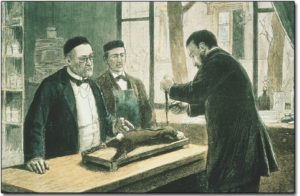
A difficulty arose in the inoculation of some rabbits with splenic virus. The first died rapidly, their blood swarming with the bacillus; other rabbits inoculated with the blood of these also died, but their blood was free from this organism. Here was a crux, one of those contradictions which seem to stultify experiment and disprove conclusion. Before this, Pasteur had shown that the healthy animal body with a whole skin is sealed against the introduction of certain lower organisms. All the internal organs in a normal state of health are absolutely free from germs or particles which can be transformed into bacteria, vibrios, monads, or microbes. But in the stomach are aérobic, and in the intestinal canal anaerobic, germs and living products in every state of development and physiological action. The vitality of the mucous lining keeps back these anaérobies from penetrating into the interior of the body. After death this vital action of repulsion ceases, and then the anaerobic vibrios rush into all parts of the body and begin their work of putrefaction and destruction. They swarm into the blood directly this ceases to be oxygenated. And in deaths by splenic fever this soon occurs, as part of the oxygen has already been taken up by the aérobic Bacillus anthracis. The septic vibrio is the most active of all anaérobies; for it must always be remembered that there are many, not one. In twelve or fifteen hours the blood of a diseased animal, which at the time of its death contained exclusively the parasite of splenic fever, has both this and the septic vibrio. Without oxygen the bacillus perishes, leaving only amorphous granulations, deprived of all virulence; the septic vibrio, on the contrary, flourishes in the deoxygenated body and putrefies its food. If an animal is inoculated with the blood taken from one dead of splenic fever soon after death, the blood communicates splenic fever only. If after a certain number of hours, it communicates at one and the same time splenic fever and setpicæmia. This last is the quickest in action, and kills the patient before splenic fever has had time to declare itself. It was septicæmia, then, which had killed the rabbits. The splenic bacteria which were searched for were not found, and the spores of the septic vibrios were overlooked. The two germs are cultivated differently. The bacillus of splenic fever needs oxygen; the septic vibrio, which oxygen would kill, has to be bred in a vacuum. Hence the two kinds can be cultivated for purposes of inoculation at will.
In the blood of a woman who had died of puerperal fever were found transparent filaments, simple or jointed, motionless, straight or bent, which a certain doctor said belonged to the genus Leptothrix. “No,” said Pasteur; “your leptothrix is the Bacillus anthracis, the bacillus of splenic fever.” Inoculation of rabbits proved that he was right; and on inquiry it was found that the woman had lived over stables.
Blood or serum full of septic vibrios, and exposed to the air, presents a curious phenomenon. The first layer or couche of vibrios dies by contact with the oxygen of the air. Beneath this couche, by which they are protected, the others multiply, until their individual life, too, comes to its terms, when they pass into spores or germs which are not affected by oxygen, but are taken up as dust and carried about by the air–forming a fatal deposit on the food of some weakly animal whose vitality is not strong enough to resist their deadly action. Putrid diseases, then, are communicated by the air carrying about, in a state of latent vitality, the spores of organisms which cannot live in the air. This, again, is another instance of the close connection and interchangeable variations of nature. Thus among the microbes of special diseases are to be found aerobies like the bacilli of splenic fever, and anaerobies like the vibrios of acute septicemia; both existing at the same time in the same body, and proving the parasitic origin of diseases.
Temperature plays an important part in parasitic diseases. Thus, splenic fever does not attack poultry, because of the high temperature of the blood. An infinitesimal quantity would kill an ox, and a large dose would not inconvenience a chicken. To prove this, Pasteur put the feet of a hen in cold water, thus lowering her temperature from the normal 41-42 to 37-38. He then inoculated her with the splenic virus. She died, and her blood was found swarming with splenic vibrios. Another, the temperature of which he also lowered in the same way, and then inoculated, recovered, because he brought back her normal warmth by wrapping her in cotton wool. By these and other like experiments he proved that Bacillus anthracis cannot live in a temperature of 44° Centigrade. Cold also arrests the development of all germs; and the practical bearing to us is the advisability of lowering the temperature of the body in typhoid and other fevers.
With the micro cocci of fowl cholera he was no less successful. He proved their harmlessness to the guinea-pig, where they often appear in abscesses, but their certain death to fowls and rabbits, which the guinea-pig inoculates. Pasteur cultivated this microbe till he attenuated its virulence, and was then able to inoculate poultry against fowl cholera, as we are protected against smallpox. It is a true virus, a true vaccine, weakened at will, and in its weakened state capable of preserving the body from the disease.
From this Pasteur passed back to the consideration of splenic fever, and on to the cultivation of the splenic bacillus, though he was met by the apparently insurmountable difficulty of the dust of spores, which retain their vitality for years, needing only moisture and the fitting nidus to develop into virulent life once more. Under its filamentous form the microbe of splenic fever is like that of fowl cholera, and cultivable to the same extent. The question, however, was how to prevent the production of the spores. He succeeded, finding the splenic microbe non-cultivable at 44-45 degrees, but easily cultivated at 42-43, when it produces no spores. At the latter temperature, then, and in contact with pure air, the filamentous parasites of splenic fever can be cultivated, but the cultivation maintained, deprived of all germs. Thus a vaccine was found from which all things were hoped.
On the 5th of May, 1881, at Melun, Pasteur inoculated with fresh splenic virus certain animals, vaccinated and not vaccinated. All the non-vaccinated sheep died, and the cows were very ill with enormous swellings behind the shoulder, at the point of inoculation, in high fever and unable to eat. The vaccinated sheep were perfectly well, and “en pleine gaité.” The vaccinated cows were eating as usual, and had neither fever nor tumor. This experiment was considered decisive; and since then vaccination against splenic fever has been largely adopted in France, the result being a striking diminution of mortality among the vaccinated as against the non-vaccinated. In sheep the numbers are 1 in 740 against 1 in 78; in cows and oxen 1 in 1,254 against 1 in 88.
The cause 0f splenic fever was supposed by M. Delafond to be due to the over-richness of the blood. Pasteur showed that it is propagated by material conditions of contagion, and especially by food. The fields where splenic animals have been pastured or buried are true splenic fever breeding-grounds. The germs in the dead body get mixed with the soil, and the worms bring this deeper infected soil to the surface, where the rain and the dew reawaken the vitality of the spores, and so pass on the disease to the next comers. Pasteur advocates the burying of infected animals in a dry, sandy, non-arable soil; but surely no argument in favor of cremation can be so strong as this revelation which he has made of the changeable conditions and persistent vitality of the spores, which are the future vibrios.
The value of Pasteur’s discoveries and applications of principles can scarcely be exaggerated. To his own country they have already more than sufficed, as Huxley says, “to cover the war indemnity of ninety-five milliards of francs paid by France to Germany.” To the world at large they represent an incalculable saving of property, mitigation of suffering, and prolongation of life, not to speak of the priceless possession of Truth. He is now sixty-two years of age, in full mental activity and energy, and deep in experiments on hydrophobia, made with chloroformed dogs. By these experiments he has proved that hydrophobia is essentially a disease of the brain, specially active in the medulla oblongata, that most delicate, highly vitalized, and important part of all; that the spinal marrow along its whole length, and the nerves throughout their whole system, may be as rabid as the saliva, once thought to be the seat of the disease; and that rabies has a microbe of its own, like every other disease hitherto investigated. After incredible pains and labor he has succeeded in isolating (though not seeing) this rabic microbe, and in cultivating it to a state of purity and attenuation fit for vaccination. The power of vaccination to protect dogs from hydrophobia was conclusively proved in the experiments made before the commission appointed by the Minister of Public Instruction to inquire into the matter; when out of nineteen unvaccinated dogs only five lived, and of twenty-three vaccinated, not one died after inoculation by the terribly virulent poison of rabies.
“Never before during the long period of its history did a day like the present dawn upon the science and art of medicine,” says Professor Tyndall in his preface to the book we have been considering.
“Indeed, previous to the discoveries of recent times, medicine was not a science, but a collection of empirical rules dependent for their interpretation and application upon sagacity of the physician. How does England stand in relation to the great work now going on around her? She is, and must be, behind hand. Scientific chauvinism is not beautiful in my eyes. Still, one can scarcely see, without deprecation and protest, the English investigator handicapped in so great a race by short-sighted and mischievous legislation. A great scientific theory of gravitation, the theory of undulation, the theory of evolution, the dynamical theory of heat–all had to push their way through conflict to victory. And so it has been with the germ theory of communicable diseases.”
We do not yet see the end of this wonderful man’s labors. Disease first mitigated and finally stamped out; industries revived and prosperity insured; true knowledge of actual causes instead of illusory reasoning on empirical hypotheses; the scientific method adopted in every branch of medical practice; the abandonment of speculative error and the acceptance of actual truth, are among the working results of that grand bit of human mechanism–Louis Pasteur’s brain. By his labors we see even more clearly the universality of organic life–a truer “materialization” than is to be found in the dreams of mystics or the visions of ecstatics; and by his investigations the chain which binds all nature into one interdependent and interacting whole become even more visible in its links and more solid in its clasp. Instead of impalpable forces acting by chemical combinations and molecular changes as occult as the alchemist’s transmutation of metals, we have tangible matter, the form of which we can see, and the modus operandi of which we can trace. Instead of the Hand of God and the ghostly mystery of superhuman viewless Influences, as the causes of disease, we have organisms with which we can deal and over which we can have absolute power. Instead of dry destruction, we have life–at once the parent and the product of death. Life lies about us everywhere, unseen, unheard, but as potent and as active as the cosmic forces which have formed and now maintain the equilibrium of the spheres. The infinitely little is the infinitely might; and that which we call death is but hte release of energies and the multiplication of activities whereby the unit is disintegrated into countless millions of organisms. When we weary of the sterile things of the world, we have always the rich and fertile fields of science for our rest and refreshment. When we are harassed and disturbed, perplexed and dismayed by the multiplicity of groundless faiths and baseless beliefs pressed on our acceptance, we have always such as Pasteur has proved to make us feel more on solid ground what is–is–and where that phantasmal disarray set forth by the lovers and makers of miracles has no place.
Footnotes
- Dr. Koch, of Berlin, by his researches published in 1876, anticipated Pasteur in the study of this organism, and was the first to give a correct account of its life-history and its relation to the splenic disease of cattle. (back)
 Pasteur Brewing Louis Pasteur – Science, Health, and Brewing
Pasteur Brewing Louis Pasteur – Science, Health, and Brewing 